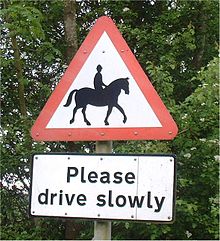Pictogram
This article needs additional citations for verification. (November 2006) |

A pictogram (also pictogramme, pictograph, or simply picto
In the field of prehistoric art, the term "pictograph" has a different definition, and specifically refers to art painted on rock surfaces. Pictographs are contrasted with petroglyphs, which are carved or incised.
Historical
Early written symbols were based on pictographs (pictures which resemble what they signify) and

Pictographs can be considered an art form, or can be considered a written language and are designated as such in
Some scientists in the field of neuropsychiatry and neuropsychology, such as Mario Christian Meyer, are studying the symbolic meaning of indigenous pictograms and petroglyphs,[7] aiming to create new ways of communication between native people and modern scientists to safeguard and valorize their cultural diversity.[8]
Modern uses
An early modern example of the extensive use of pictographs may be seen in the map in the London suburban timetables of the London and North Eastern Railway, 1936–1947, designed by
Pictographic writing as a modernist poetic technique is credited to Ezra Pound, though French surrealists credit the Pacific Northwest American Indians of Alaska who introduced writing, via totem poles, to North America.[12]
Contemporary artist Xu Bing created Book from the Ground, a universal language made up of pictograms collected from around the world. A Book from the Ground chat program has been exhibited in museums and galleries internationally.
In mathematics
In statistics, pictograms are charts in which icons represent numbers to make it more interesting and easier to understand. A key is often included to indicate what each icon represents. All icons must be of the same size, but a fraction of an icon can be used to show the respective fraction of that amount.[13]
For example, the following table:
| Day | Letters sent |
|---|---|
| Monday | 10 |
| Tuesday | 17 |
| Wednesday | 29 |
| Thursday | 41 |
| Friday | 18 |
can be graphed as follows:
| Day | Letters sent |
|---|---|
| Monday | |
| Tuesday | |
| Wednesday | |
| Thursday | |
| Friday |
As the values are rounded to the nearest 5 letters, the second icon on Tuesday is the left half of the original.
Standardization
Pictographs can often transcend languages in that they can communicate to speakers of a number of tongues and language families equally effectively, even if the languages and cultures are completely different. This is why road signs and similar pictographic material are often applied as global standards expected to be understood by nearly all.
A standard set of pictographs was defined in the
Pictograms have been popularized in use on the Internet and in
-
Horseshoe Canyon, Canyonlands National Park
-
Sample National Park Service pictographs
-
This highly influential pictogram design was introduced at the1972 Munich Olympics, although pictograms first began to appear in the games at Tokyo in 1964.
-
British Rail passenger safety pictographs at the end of the platform at Meols railway station
-
Water, rabbit, deer pictographs on a replica of anStone of the Sun
See also
- Bouba/kiki effect
- Crop art
- Emoticon
- Emoji
- Icon (computing)
- Ideasthesia
- Ideogram
- List of Stone Age art
- List of symbols
- List of writing systems § Pictographic/ideographic writing systems
- Pecked curvilinear nucleated
- Petroform
- Petroglyph
- Rebus
- Road sign
- Rock art
- Rock art of the Chumash people
- Sound symbolism
- Stick figure, in art
- Symbol
- Traffic sign
- Warning sign
- Yakima Indian Painted Rocks
Notes
- ISBN 0-87779-201-1.
- )
- ^ "Signatures from the Past". ESO.org. European Southern Observatory. 30 January 2017. Retrieved 30 January 2017.
- ISBN 9783945561133.
- S2CID 198820112.
- ^ "Petroglyphic Complexes of the Mongolian Altai". WHC.UNESCO.org. UNESCO World Heritage Centre. 2011.
- ^ Meyer, Mario Christian (December 1985). Apprentissage de la langue maternelle écrite: étude sur des populations "les moins favorisées" dans une approche interdisciplinaire (PDF). ED-85/WS/65.
- ^ Meyer, Mario Christian. "Out Of The Forest & Into The Lab: Amerindian Initiation Into Sacred Science" (PDF). In Bloom, Pamela (ed.). Amazon Up Close. Archived from the original (PDF) on 2012-03-17.
- ^ Hall, C. Justin; Allen, Zachary. "Olympic Pictograms". Visual Rhetoric.
- ^ "Olympic Pictograms: Design through History". MediaMadeGreat.com. 16 August 2016.
- ^ Popovic, John Jan (ed.). "Olympic Games Pictograms". 1stMuse.com.
- ^ Reed 2003, p. xix
- ^ "Understanding pictograms". BBC — Skillswise. Archived from the original on 2013-12-29. Retrieved 2014-05-11.
References
- ISBN 1-56025-458-0.
External links
- Pictogram & Communication: About 1,500 practical pictograms based on Design principles of pictorial symbols for communication support(JIS T 0103:2005)
- CAPL:The Culturally Authentic Pictorial Lexicon, photographic illustrations of objects for multiple languages
- Pictogram Encyclopedia, The collection site of more than 500 pictograms, Pictograms are categorized, and easy to find unique pictogram
- Pictopen - Modern Pictographic Writing
- NounProject - Free Pictograms under open licences
- Modern Pictograms - Explore word and pictogram relationships
- Wolfram|Alpha - Number to pictogram translator
- icons - download free icons for commercial and non commercial uses





